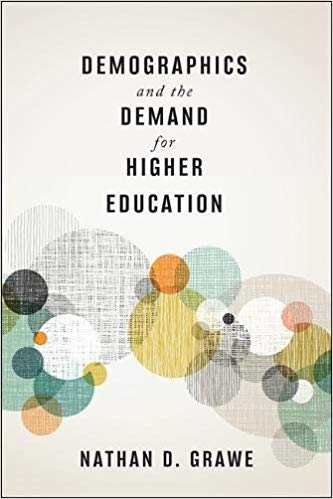Reading ‘Demographics and the Demand for Higher Education’ Through a Learning Innovation Lens

 Demographics and the Demand for Higher Education by Nathan D. Grawe
Demographics and the Demand for Higher Education by Nathan D. Grawe
How might Nathan Grawe’s book, Demographics and the Demand for Higher Education, be read through a learning innovation lens?
Would someone who spend their days thinking about digital and online education, learning science and organizational change, approach this book differently than other academics?
As a lapsed demographer, I found great joy in reading Grawe’s methodologically beautiful forecasts of future college demand. As a higher ed person, Grawe’s projections for declines in the numbers of new high school graduates within a decade scared the shit out of me.
I’m not sure that our industry has entirely absorbed how challenging it will be to find traditional-age students in the coming years. Moreover, I worry that some schools feel that they will be immune from the future demographic challenges – insulated by their status and wealth.
Where I think that a learning innovation person may read Demographics and the Demand for Higher Education differently from perhaps other academics is around the framing of institutional hierarchies. Grawe looks at the impact of demographic trends on three distinct institutional types: Regional, National, and Elite. (Using the U.S. News & World Report Ranking).
The Elite, or highly competitive, schools are those ranked in the top 50 – and which recruit nationally and worldwide. National institutions, ranked 51-100, have national brands – but still recruit most of their students from within 110 miles. Finally, Regional institutions (outside of the top-ranked 100) recruit fairly locally, with half of enrolled students living 60 miles away from campus or less.
While Grawe acknowledges some demographic pressures for Elite schools in the Northeast and the Midwest, he thinks that these schools will have little trouble filling their classes. For National colleges and universities, Grawe anticipates the need for significant shifts in recruiting practices for those schools situated in the areas of sharpest demographic decline.
Where I part from Grawe, and where my learning innovation lens comes into play, is in my skepticism in the stability of the existing status hierarchy.
I think that it would be a mistake to assume that we will find the same schools in the “Elite” category in 2030 that we see in 2019. Further, I think that Regional institutions can supplant many of the existing schools now ranked in the National category.
My rationale for believing that there is a non-trivial probability of a large-scale institutional status re-sorting in the next decade grows out of my observations around the rapid pace of institution-led learning innovations across the postsecondary ecosystem.
We are now in the middle of an unacknowledged renaissance of student learning. Many institutions are investing large quantities of resources and attention in remaking the student learning experience.
These institutional investments in learning, however, are not universal. Some schools have a long-term plan and the fortitude to stick with reinvention. Others lack the vision and the discipline for transformation.
What I hypothesize is that the re-sorting of institutional status will be driven by the results of investments in learning innovation.
Elite and National universities that fail to invest in learning innovation may find themselves more vulnerable than they expected to the demographically driven declines in student demand.
Higher leaders, if they want to ensure the resiliency and relevancy of their institutions, need to develop the capacity to think about both demographics and learning innovation.
Today’s Elite or National status is not a protection, as status is a variable, not a constant.
What are you reading?
